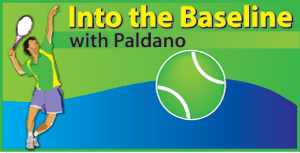Return of the net-game
 The current ‘Australian-Open’, shows the return and dominance of the ‘net-game’. Players want to reduce the length of the rally to survive the grueling Australian heat and the eleven-month professional circuit. Length of the rally has a direct impact when it comes to physical injuries.
The current ‘Australian-Open’, shows the return and dominance of the ‘net-game’. Players want to reduce the length of the rally to survive the grueling Australian heat and the eleven-month professional circuit. Length of the rally has a direct impact when it comes to physical injuries.
With a variable net-game they are hitting winning volleys and forcing errors in opponents. This grass-court formula to win went into obscurity after the advent of the synthetic racquets which gave immense power to ground strokes and made the ‘passing shot’ easy or better said easier.
The very even synthetic courts also made the passing shot great deal easier. Now the players have caught up with the reaction and game-plan needed to execute the net-game successfully on the synthetic courts. It was more prominent in the men’s game and in some top women’s games.
The net-game became ineffective in the period dominated by the Swedes Bjorn Borg, Mats Wilander and their follow-ups Jimmy Connors and Ivan Lendl.
Baseline-game got established so severely that the new comers who took up the game in that era never ever got a grip to volley, let alone use the volley as a stroke.
One of the negative end-effects was the physical break down of players having to practice ground strokes in ten thousands and have long rallies to win, which literally ‘ruined’ young players backs and knees for life.
Most of the baseliners had to leave the game injured and some are walking with hip replacements. Baseline-game rallies are long and not tactically progressive enough towards an advantage.
In such situation it was the fitness that decided the outcome of a ground stroke rally and not Tennis skills. In which case, marathon is a better pursuit. What more, the inability to volley, killed doubles altogether. Net-Game
Although there was a spurt of strong net games from Stephan Edberg, it was Pete Sampras who brought it back to dominate the Tennis world. The reward is, apart from being number one for nearly a decade, he is still walking without any surgery.
Why is the net-game so effective? Playing at net takes away large chunks opponent’s advantages in time, court targets, shot selection and above all shortens the rally creating a strong tactical progression with ‘every shot’.
This is what we are witnessing in Melbourne’s Australian-Open. Except for the Spanish baseliners, others have taken to go to net. Federer bringing-in Swedish maestro Stephan Edberg into his team has made him a good volley maker now. To become so good so late in life means the volley-game could be his secret.
New faces?
Quarter-finals is a good stage to spot a good player breaking ground to be elite. Canadian Milos Raonic of whom not much was heard last year has shown that he did not waste the year.
He won the Brisbane title beating Roger Federer and now is in the semi-finals of Aus-Open. His secret is the addition of a very strong net-game. His formidable height and reach is giving him all the advantages at net.
He beat much fancied Stanislas Wawrinka in tough match. He has matured to enter the top five now. The names in the men’s side Tennis has not changed much in the quarter finals stage.
Two players have surfaced in the women’s side. First is China’s twenty-seven-year-old Zhang Shui. She was in the top 30, then went down to 133 and had to play qualifying rounds to come into the main rounds this year.
She was facing the gloom of having to retire from the game after losing 14 times in the first round of Grand-Slams in eight years. She has come out of the hoodoo.
From a qualifier she became a quarter-finalists. Her match against Madison Keys did not bring the best in her as she won only when Keys developed baseliners back injury in the second set. It seems as if Shui chokes during important points and that is not a quality of a champion.
Regardless of that China got into the quarter-finals of a Grand-slam for the first time after Li-Na. Her achievement at the Aussie-Open also makes her Chain’s number one.
The other, is the Australian born Johanna Konta of England, who with Andy Murray has made history. This is the first time since 1977 an English Woman and a man are in the semi-finals.Her appearance is sudden.
Last year she had to play qualifying rounds. She is an excellent mover with a light frame, good strokes and a significant net-game. She can ace with a first serve but it is said that her service is ‘still work-in-progress’. Her prospects seem good as she has the ‘all court game.’
In the women’s side there are three seasoned campaigners and a fresh name in the semis. In men’s, all are known names holding Fort.
Retirement as such doesn’t seem to be an issue even at 35 for today’s players. With money available in each round of the professional tour, they seem to prefer to fade away than to drop-off.
The older ones are using game-plans to shorten the rallies and survive. The Net-game has become such a devise in the Tennis world today.
George Paldano, Former int. player; Accredited Coach of Germany; National, Davis-Cup, Federation Cup coach–. georgepaldano@yahoo.com


